If you want to know about the active and passive solar architecture or site analysis or principle of daylighting design, please click the link.
Fixed shading devices are architectural features that are permanently attached to a building’s exterior and are designed to provide shade and reduce solar heat gain. They can help reduce the amount of solar radiation that enters a building, which can lead to lower cooling costs and greater energy efficiency.
Fixed shading
- Fixed shading devices (eaves, awnings, pergolas and louvres) can regulate solar access on northern elevations throughout the year, without requiring any user effort.
- Summer sun from the north is at a high angle and is easily excluded by fixed horizontal devices over openings.
- Winter sun from the north is at a lower angle and penetrates beneath these devices if correctly designed.
Eaves
- Correctly designed eaves are generally the simplest and least expensive shading method for northern elevations and are all that is required on most single-storey houses.
- Some designers may avoid sizing eaves properly in the mistaken belief that the process is complex.
- Precise angles for each latitude can be calculated using the simple process above.
- They only vary the day and month that sun begins to strike the glass in autumn and shade it in spring because the movement of the sun is most noticeable to us around the spring and autumn equinoxes.
- This is due to the ‘apparent’ movement of the sun slowing as it changes direction at each solstice due to the earth’s tilted axis as it orbits around the sun.
- The following simple rules of thumb ensure that north-facing glass is fully shaded for a month either side of the summer solstice and receives full solar access for a month either side of the winter solstice.

- 45% rule of thumb for latitudes south of and including 27.5°S.
- As a rule of thumb, eaves width should be 45% of the height from the window sill to the bottom of the eaves.
- Aim for consistent sill heights where possible and consider extending the eaves overhang over full height doors or windows.
- This allows the 45% rule to be simply met with the following standard eaves overhangs:
- 450mm where height is 900–1200mm
- 600mm for a height of 1200–1350mm
- 900mm for a height of 1350–2100mm
- 1200mm for a height of 2100–2700mm.
- Where sill heights vary on a single north façade, set your eaves overhang to the average sill height of larger glass areas.
- In warmer climates go up to the nearest size and in cooler climates go down to the nearest size.
- Think about how climate change and warming might affect the heating requirements of the home.
- To avoid having permanently shaded glass at the top of the window, ensure that distances between the top of glazing and the eaves underside are at least 30% of the height — a more important component of eaves design than width of overhang, especially in cool and cold climates where it is a significant source of heat loss at night with no compensating daytime solar gains.
- It is not always achievable with standard eaves detailing which is flush with the 2100mm head (i.e. height of the top of the window).
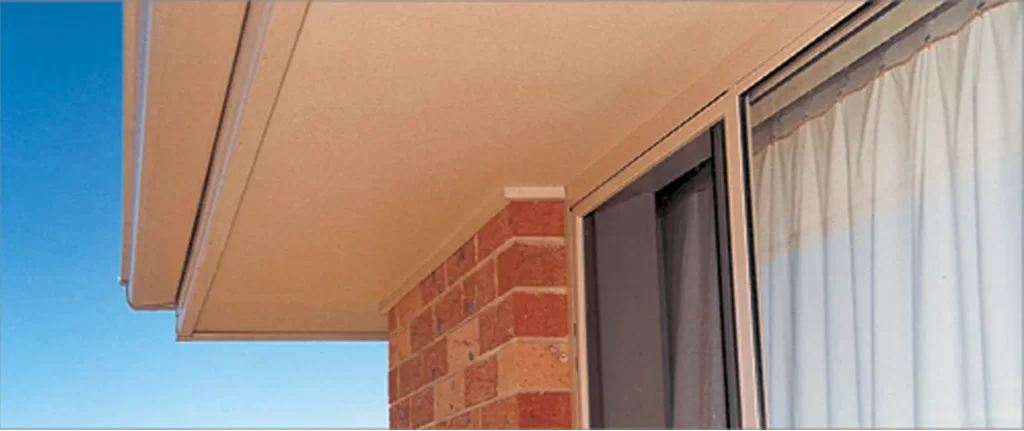
- The top 20% of this window is in permanent shade.
- In the image below, standard 2100mm high doors are shaded by 1000mm eaves (including gutter) set 300mm above the head. Note the sun angle at midday in mid-winter is above the glass line.
- This configuration provides full shading to the glass from late October to late February at latitude 35°S (near Canberra) and is appropriate for a higher altitude cool climate winter.

- Eaves can be sized to allow shading in summer and solar access in winter.
- North-facing upward raked eaves allow full exposure of glass to winter sun and shade larger areas in summer, without compromising the solar access of neighbours to the south.
- A separate horizontal projection of louvres shades lower glazing. This allows 100% winter solar access and excludes all sun between the spring and autumn equinoxes.
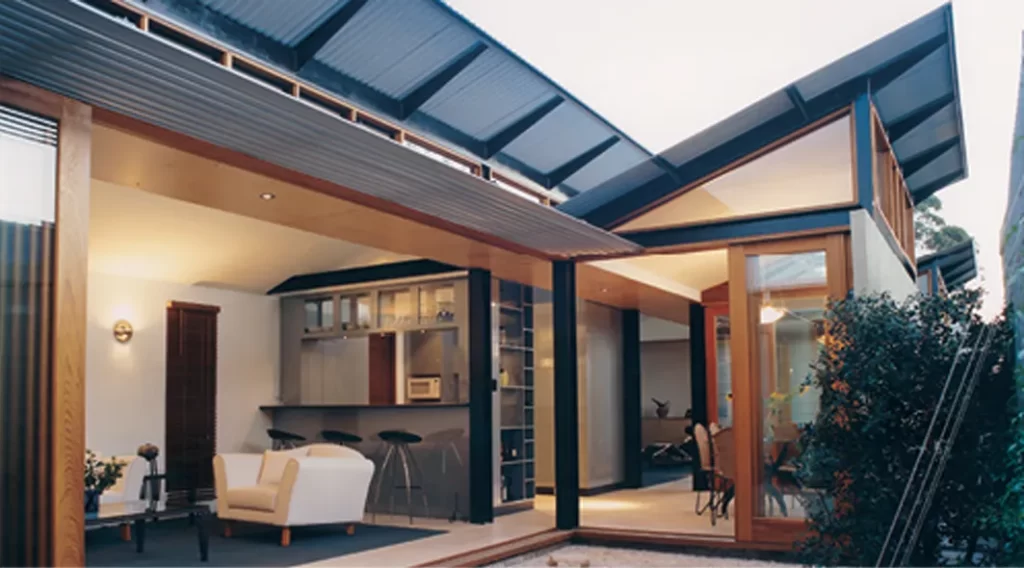
- North-facing upward raked eaves.
- Horizontal shading devices must extend beyond the width of the north-facing opening by the same distance as their outward projection to shade the glass before and after noon.
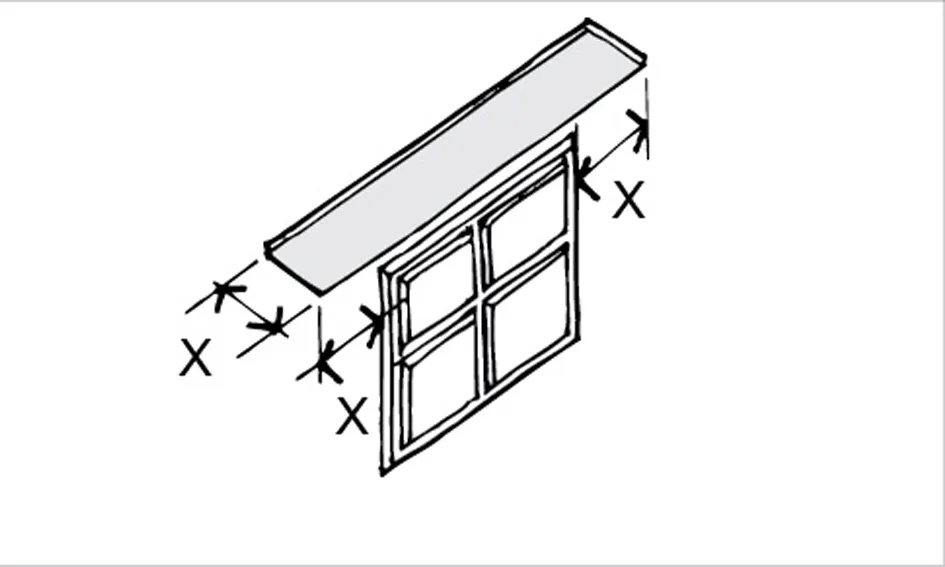
- Extend shading beyond the window edges.
Varying the rule of thumb
Variations to the 45% rule of thumb are beneficial for fine-tuning your passive shading to suit varying heating and cooling requirements determined by regional climate, topography and house design.
For example, reduce the overhang by decreasing the percentage of the height by up to 3% to extend the heating season:
- at higher altitudes (e.g. eastern highlands, tablelands and alpine regions)
- where cold winds or ocean currents are prevalent (e.g. southern Western Australia and South Australia)
- in inland areas with hot dry summers and cold winters (e.g. Alice Springs)
- in cold, high latitude areas (e.g. Tasmania and southern Victoria).
Gradually increase the percentage of height as heating requirements decrease in latitudes north of 27.5°S (Brisbane), to decrease or eliminate the amount of sun reaching glass areas either side of the equinox:
- For hot dry climates with some heating requirements, gradually increase the overhang up to 50% of height (full shading).
- For hot humid climates and hot dry climates with no heating requirements, shade the whole building at all times with eaves overhangs of 50% of height from floor level to both north and south where possible, and use planting or adjoining buildings where it is not possible.
- East and west elevations require different solutions.
Louvres
- Fixed horizontal louvres set to the noon mid-winter sun angle and spaced correctly allow winter heating and summer shading in locations with cooler winters.
- As a rule of thumb, the spacing (S) between fixed horizontal louvres should be 75% of their width (W).
- The louvres should be as thin as possible to avoid blocking out the winter sun.
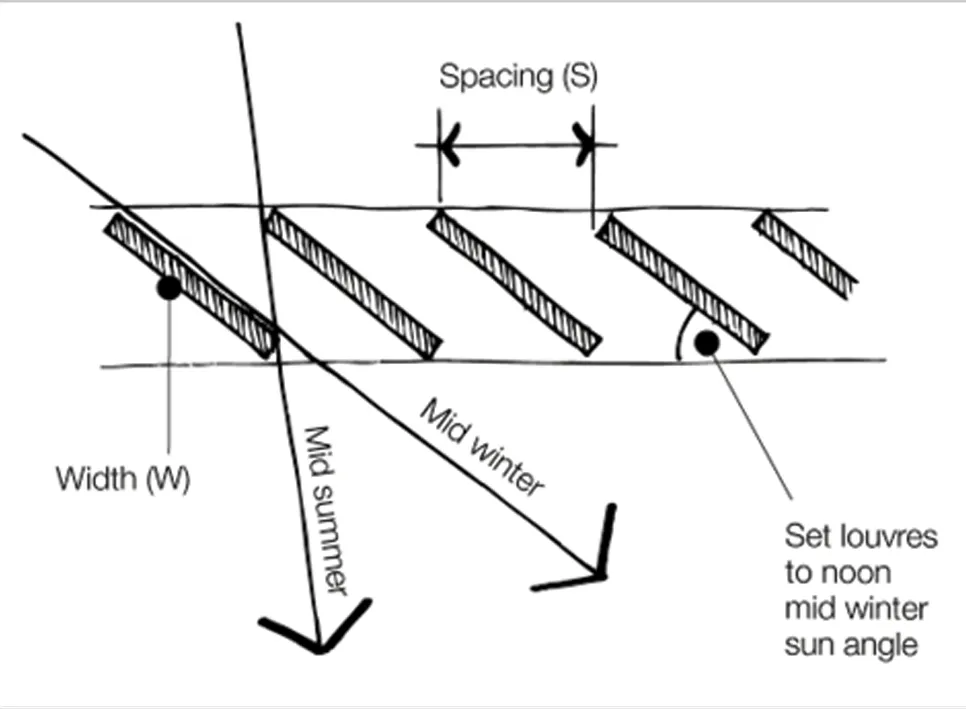
Spacing for fixed louvres.
Fixed shading for east and west
- West-facing glass and walls are a significant source of heat gain in hotter climates.
- East-facing glass can be equally problematic because, while the home is cooler in the morning and heat gains do not cause noticeable discomfort, it is the start of a cumulative process that causes thermal discomfort in the afternoon and early evening.
- Both east and west require shading in hotter climates.
- In cooler climates, east shading is a lower priority.
- Because east and west sun angles are low, vertical shading structures are useful in allowing light, views and ventilation while excluding sun.
- Roof overhangs, pergolas and verandas that incorporate vertical structures such as screens, climber covered lattice and vertical awnings are also effective.

- Pergola with vertical screen to block low-angle sun.
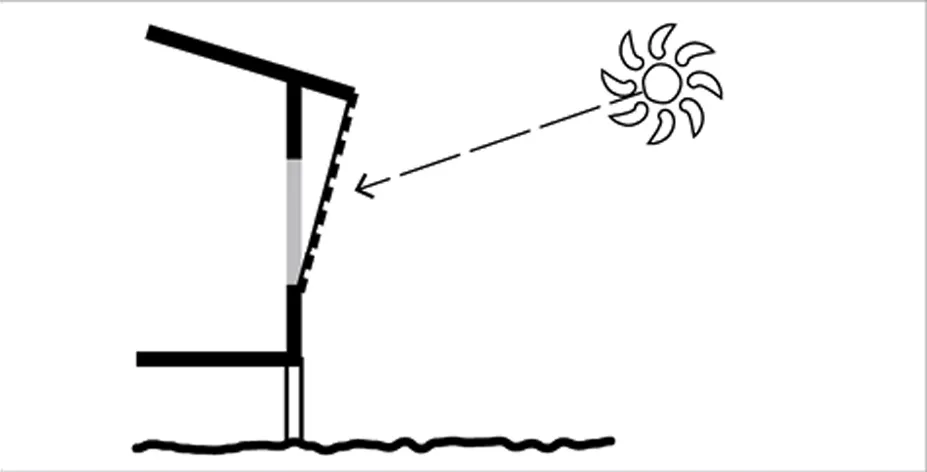
- Vertical timber batten screen attached to the house.
1) Adjustable shading
- Adjustable shading allows the user to choose the desired level of shade.
- This is particularly useful in spring and autumn when heating and cooling needs are variable (Note: Active systems require active users).
Climate change
- Climate change does not affect sun angles, but the desirability of shade or solar heat gain may change, thus affecting the overall design strategy.
- Adjustable shading (mechanical or seasonal vegetation) facilitates adaptation to changing climatic conditions.
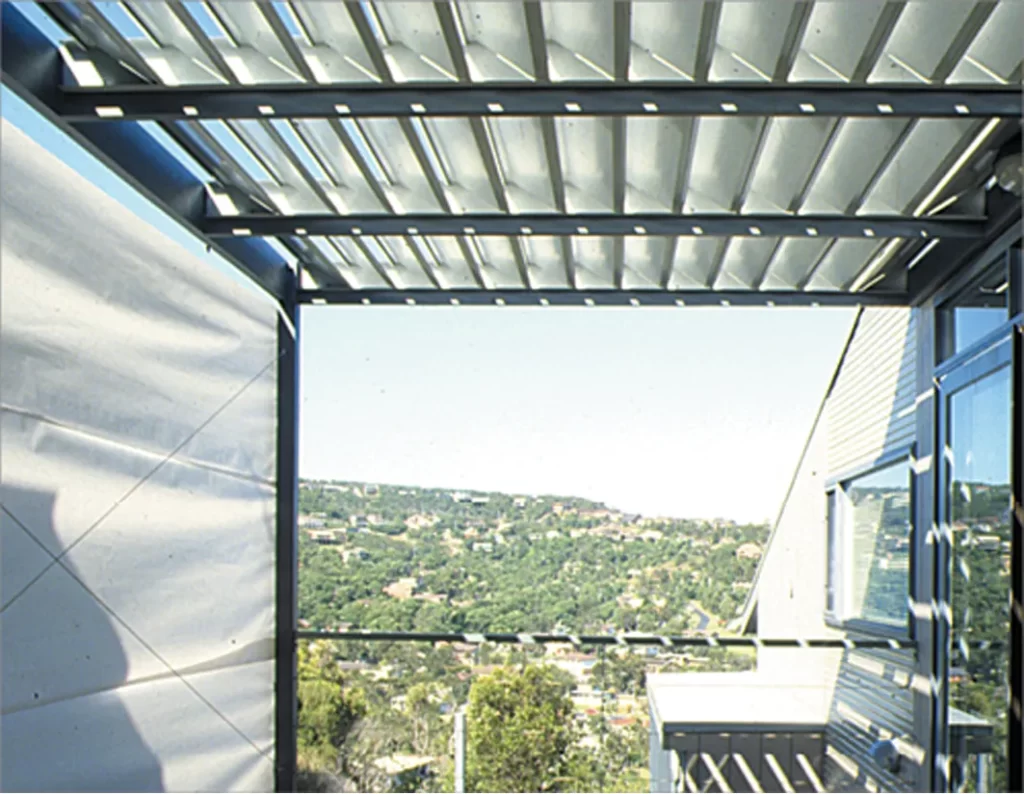
Adjustable louvres can adapt to changing climate conditions.
Northern elevations
- Adjustable shading appropriate for northern elevations includes adjustable awnings or horizontal louvre systems and removable shade cloth over pergolas or sails.
- Shade cloth is a particularly flexible and low cost solution.
Eastern & western elevations
- Adjustable shading is especially useful for eastern and western elevations, as the low angle of the sun makes it difficult to get adequate protection from fixed shading.
- Adjustable shading gives greater control while enabling daylight levels and views to be manipulated.
- Appropriate adjustable systems include sliding screens, louvre screens, shutters, retractable awnings and adjustable external blinds.

- Awnings and roller shutters provide adjustable shading on eastern and western elevations.
North-east & north-west elevations
- Adjustable shading is recommended for these elevations as they receive a combination of high and low angle sun throughout the day.
- Typical responses for northern and eastern or western elevations need to be integrated. Select systems that allow the user to exclude all sun in summer, gain full sun in winter, and manipulate sun levels at other times.
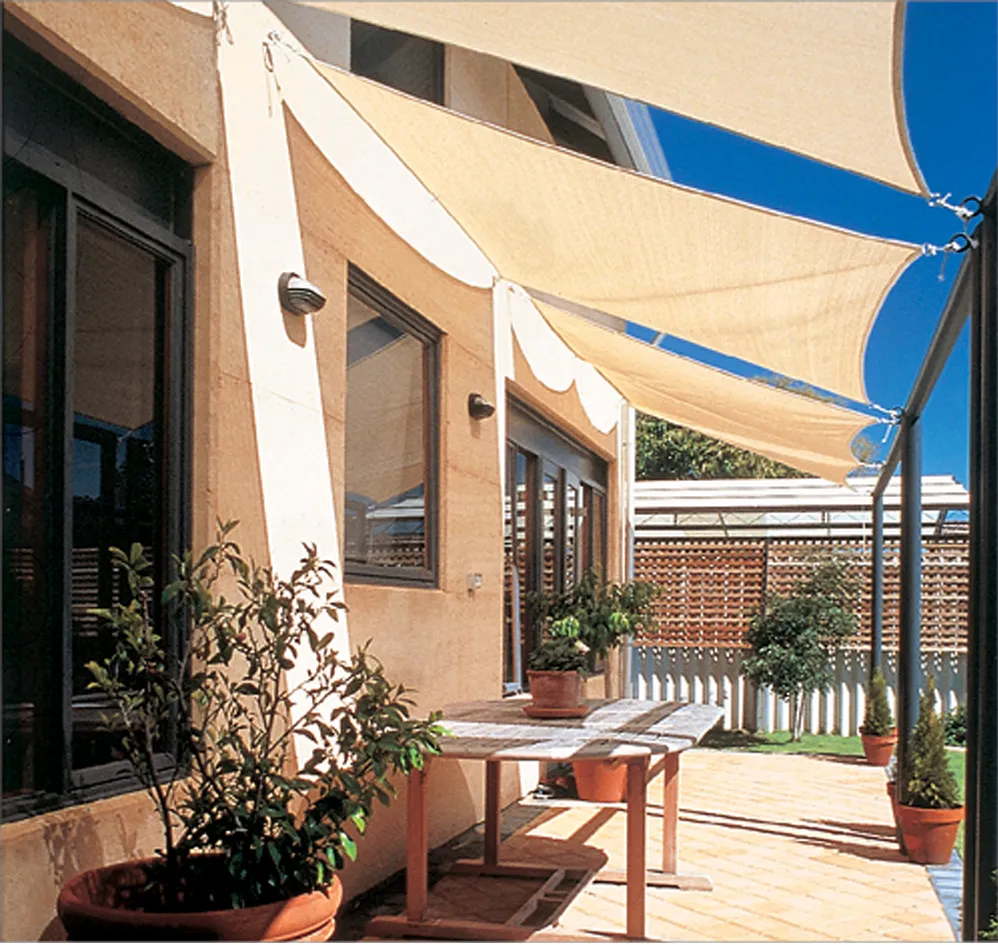
Shade cloth is flexible and low cost.
Overall, fixed shading devices are an effective way to improve energy efficiency, reduce cooling costs, and provide greater comfort for building occupants.